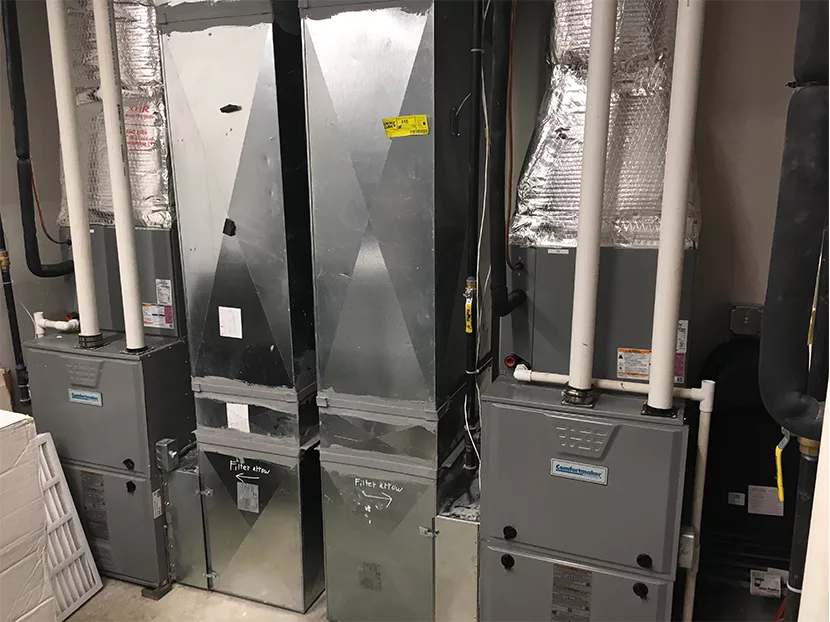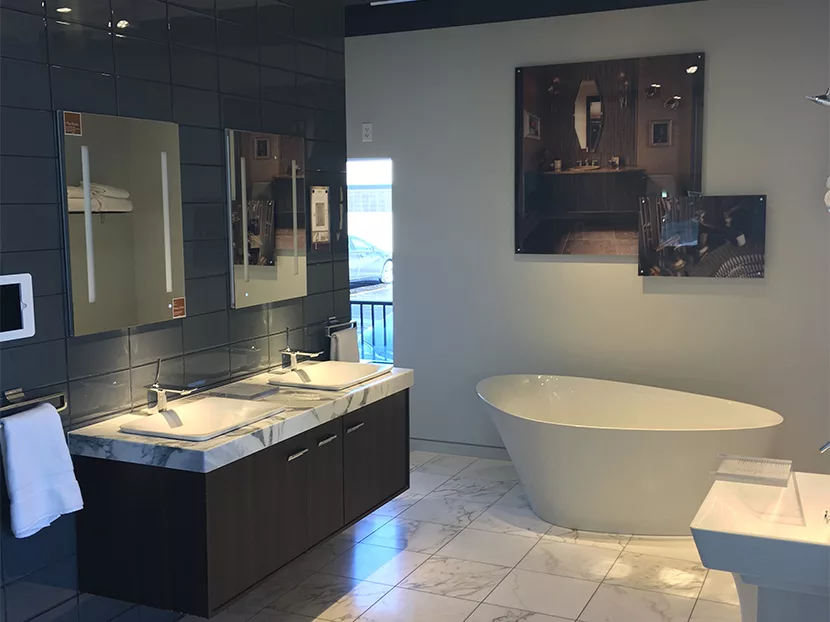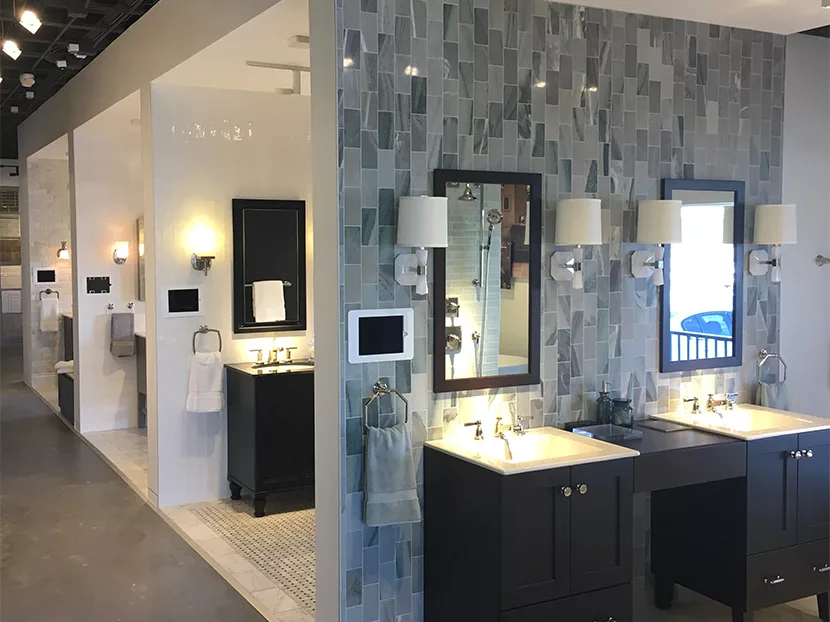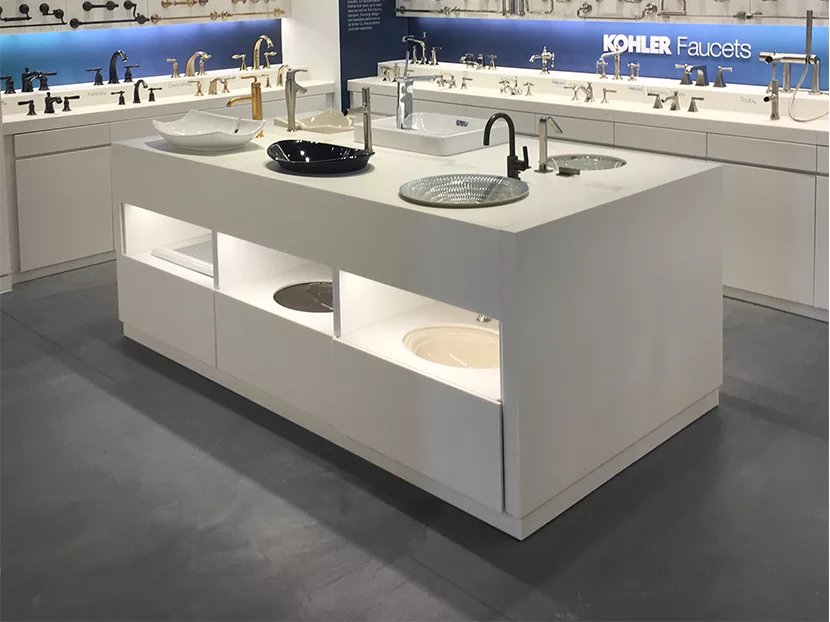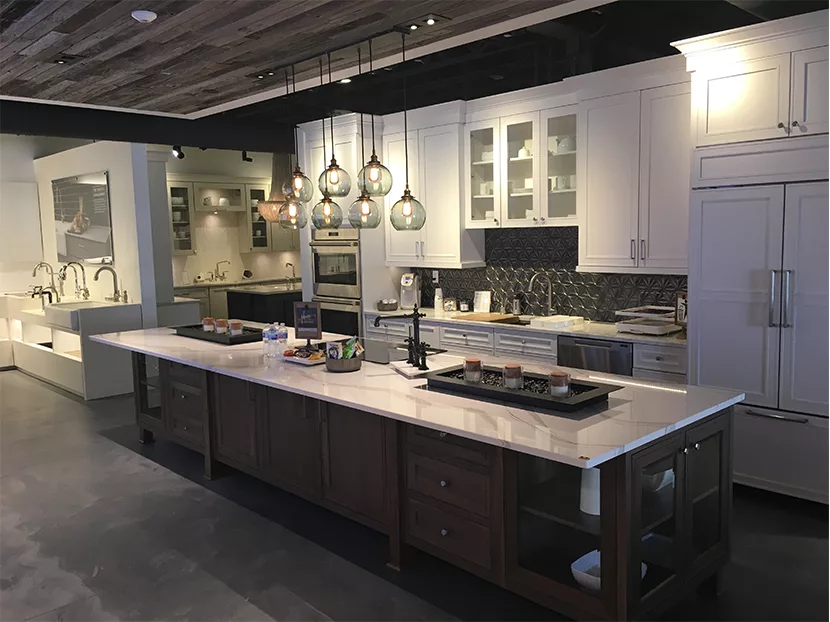Take a walk through the front door of the Kohler Signature Store in Wauwatosa, Wisconsin, and you’ll see exactly what you’d expect inside such an opulent showroom run by First Supply.
For this tour, however, keep walking … past the vignettes, past the working shower displays, past the Ann Sacks tile display, even past the Milwaukee-area’s largest selection of Kallista products.
Take a left at the conference room, a quick jog to the right and open the last door on the right. No, you’re not there yet. Keep walking through the office area tucked away inside, and, finally, open the door in the back.
Inside, a rather cramped mechanical room won’t be on the list for many of the shoppers at the store, but for our purposes, the mechanical room is just as glamorous as the displays out front.
Because what’s in here, namely a few high-efficiency furnaces and a controller, are the main reasons First Supply became the first retail space in the U.S. to receive LEED Gold certification under the LEED v4 guidelines in April 2017.
“I’ve never seen an energy analysis come within 10 percent of what actually happens,” says James Poehling, PE, vice president of engineering services for First Supply. “And if you do get within 10 percent, you’re still doing great. But this showroom is performing within 1 percent.”
The award-winning Kohler Signature Store is located on the first floor of a two-story plus basement building. So the site does benefit from a warm floor and ceiling, plus two of the walls are interior.
With Poehling being an engineer since 1971, he’ll be sure to add that the 5,806 square feet of floor area equals 69,678 cubic feet volume; the calculated heat loss is 182,400 BTU/hr (from the energy simulation) or 88,936 BTU/hr from his own calculations. (A third-party firm as a requirement for LEED certification did the energy simulation.)
The basics
Here are the basics that Poehling told us about originally in his design of the HVAC and electrical usage at the Kohler Signature Store:
- The store is divided into three zones, each with its own heating and cooling equipment. This helps minimize over and undercooling of each of the three zones.
- The three furnaces are 1) 97 percent and 2) 98 percent AFUE.
- They have ECM blowers that are variable speed. ECM motors are 30-40 percent more efficient than the conventional PSC motors found in normal furnaces.
- The burners are modulating fire to maintain a constant discharge temperature. This helps maintain a constant discharge temperature as the air flow changes.
- The cooling is done with SEER 16 (performs like SEER 19) Comfortmaker condensers and coils.
- The condensers are variable speed for the outdoor fan.
- The compressors are variable speed, which allows a constant discharge temperature throughout the air flow ranges.
- The fresh air for the showroom is controlled by a Honeywell “Jade” economizer controller.
- The controller has a carbon dioxide sensor attached to it to maintain a carbon dioxide level between 400 and 1,000 ppm.
- The outside air and the return air both has enthalpy sensors installed. This allows the controller to choose which air stream has the lowest energy requirements for heating or cooling the space and will use that air stream preferentially.
- The system maintains a positive pressure within the space using a differential pressure controller. This prevents unpleasant infiltration from doors.
- The lighting system has 24 programmable zones within the store.
- All of the space lighting fixtures are LED for minimum heat gain and maximum electrical efficiency.
- The zones near windows have photocell sensors to lower the output of the LED fixtures when the outdoor light is bright enough.
- All zones have “occupancy sensors” that work off both motion and infrared detection. If a zone does not sense anyone in the zone for 15 minutes, the lighting level will drop to 50 percent output. After 30 minutes of no one in the space, that part of the showroom will turn off.
- There is a time clock and photocell to control the lighting for the outdoor building signage. From midnight to 5 a.m., the signage is not lit. The photocell allows the signage to be lit on the dark days of winter without any intervention by the sales personnel.
First Supply’s Long History in K&B
First Supply, which celebrated 120 years in business last year, has long been a player in the kitchen and bath market.
Just how long? Try Sept. 10, 1897. That’s the date on a first quote the company received for a bathtub from Kohler. A copy of the letter, addressed to great-grandfather of the current generation of Poehlings running the business and signed by Robert Kohler, treasurer of what was then called “Kohler, Hayssen & Stehn Mfg Co.” is strategically located on a display wall just inside the Wauwatosa Kohler Signature Store.
Later, another business landmark for First Supply came in 1940 when Gary “Gerhard” Poehling opened up what likely was the first bath and kitchen showroom at the company’s LaCrosse, Wisconsin, operations. (In 1987, First Supply named its chain of showrooms “Gerhard’s” in his honor.)
Currently, First Supply currently operates 14 Gerhard’s Kitchen and Bath stores with a total of 100,000 square feet of display in all.
First Supply opened the first Kohler Signature Store in Edina, Minnesota in 2012. At the time, it was first stand-alone retail venture for Kohler. Wauwatosa was First Supply’s second Kohler Signature Store, and the first such store to open in Wisconsin. The company has since opened a third Kohler Signature Store in Overland Park, Kansas and will soon open a fourth in Birmingham, Michigan.
The data
When we met Poehling last February for a tour, he gave a general benchmark to compare the Wauwatosa Kohler Signature Store with the company’s first Kohler Signature Store, which was opened six years ago in Edina, Minnesota.
“What we find is that the Kohler showroom in Edina used 15.12 kW per square foot, per year,” Poehling explains. “And what this showroom used last year was 8.96 kW per square foot, per year.”
Poehling left us with a 100-page three-ring binder chock full of data. It’s a lot to convey succinctly, but he did tell us that the key to the performance of the space is the required amount of make-up air for the facility. That amount by code is 225 cfm, which is provided by the exhaust fans in the restrooms.
“I opted to design with 585 cfm of fresh air – the minimum required plus 360 cfm for anticipated infiltration,” he says. “By using controlled outside air instead of infiltration, cold spots are minimized.”
The space is pressurized to 0.03 inches water column. This puts about 5-psi force against each man-door. If the building were tighter, the relief damper would begin to open to hold the differential pressure of the space between 0.03 and 0.05 inches w.c. This becomes important when additional outside air to offset the required cooling instead of running the condensers.
“We now control the air flow, instead of letting the air infiltrate around windows and doors and create cold spots,” he adds.
The bin temperature data for Milwaukee shows that the electrical load within the showroom will provide all the heating required down to 7.70 F.
“For Milwaukee, this leaves only 45 hours per year where the internal lighting will not handle the entire heating load,” Poehling explains. “During the winters of 2016 and 2017, the heating load calculation shows that we should have consumed 2,253 therms of energy, but we actually consumed 23 therms of natural gas energy, or 1 percent of the calculated energy consumption.”
The “brain” that allows the space to function with such precision is thanks to the Jade economizer system control from Honeywell.
“If the system had not been designed with a total economizer system, then the condensers would need to begin running at outdoor temperatures above 27 F. With the economizer system, increasing amounts of fresh air handle the building load to 62 F. The number of hours, from the bin temperature data, between 27 and 67, is 7,277 hours.
“Without the full economizer system, it would have required 11,432 ton-hours of cooling,” Poehling adds. “The condensers used on this project are SEER 16 units, approximately 1.1 kW per ton.”
During the non-summer months, the kW per day average for 2017 is 162; during the summer months, the average moves 194 kW per day. The increase is 32 kW per day. Using an 8-hour open time, this works out to a 4 kWh increase per hour during the summer. Based on 1.1 kW per ton of cooling (SEER 16 equipment), this corresponds to a cooling load of 3.6 tons per hour.
“From the ‘bin temperature data’ analysis,” Poehling says. “I would expect an average of 6.7 tons of cooling. The difference is probably explained by the multi-stage operation of the condensing units. When they are operating at 1/2 or 2/3 of input power, the SEER level will be above the average of SEER 16.”
During the heating mode, typically only one of the three furnaces will fire – the one with a thermostat that’s in the “window zone.”
The winter operating temperature is schedule to be 72 F during occupied mode and 66 F during the unoccupied mode. Staff can send an email to the corporate office if they’re too cold. But to date, no one has sent any emails.
“During cooling, typically two or all three condensing units will be running, with 10 tons of cooling available,” Poehling says. “They will all be running at the lowest energy input, or the highest SEER.”
As far as payback, Poehling says the entire economizer control system, installation, and dampers added $4,200 to the cost of the new system.
“The economizer system saved about $1,900 during 2017 or a payback in 2.2 years,” Poehling says. “This works out to be a return on investment of 35 percent per year over the 10-year life expectancy of the equipment.”
Other sustainable efforts
The Wauwatosa Signature Store has the company’s most sophisticated heating and cooling strategy in place. The building pressurization concept was originally done when the company opened a Gerhard’s in nearby Whitefish Bay.
Poehling’s official title may be vice president of engineering services, but to us, he sounds, unofficially, like the director of sustainable design.
“The entire industry is moving toward green products,” he says, “I’ve just been a little more vocal about it.”
Poehling’s green-building experience also includes running a commissioning company and providing commission service for two LEED Platinum buildings as well as numerous other LEED certified buildings throughout Wisconsin.
Added up, First Supply wholesale and showroom operations total more than 1 million square feet of heated space with 120,000 square feet of that space needing air-conditioning, too, at 28 company locations plus nine stand-alone stores in the upper Midwest.
We first met Poehling in 2016 after First Supply held its grand opening for the Kohler Signature Store.
“Besides being a beautiful showroom,” he told us back then, “it is also state of the art and energy efficient.”
Poehling is in charge of 11 designers at eight locations who help devise systems for contractors and other builders. But he’s also responsible for the mechanical equipment designs at First Supply.
Energy consumption at all the company’s location are tracked and compiled in a monthly and yearly database. When energy consumption rises above historical levels at a facility, Poehling provides the retro-commissioning to bring the facility back into conformance or provides an engineering plan to modernize the existing equipment for higher efficiencies.
“All the locations are then compared by square footage and degree-days,” he said. “This helps determine where to place ‘new dollars’ into lowering energy costs for the company.”
Those efforts could include designing a new warehouse in Platteville, Wisconsin in 2005 that includes radiant floor heating and extra wall and ceiling installation or a new facility in Tomah, Wisconsin, with radiant floor heating and mini-splits for spot cooling.
While not energy-related, we found another interesting green campaign buried in the material Poehling left us.
The company is also monitoring the cleaning chemicals used to keep the space looking top-notch. The human resources department will monitor sick days and illnesses and keep track of the cleaning chemicals used. If testing at the Wauwatosa store shows an improvement in staff health as well as increased customer satisfaction, then the lessons learned may be implemented throughout all the showrooms and warehousing facilities.
